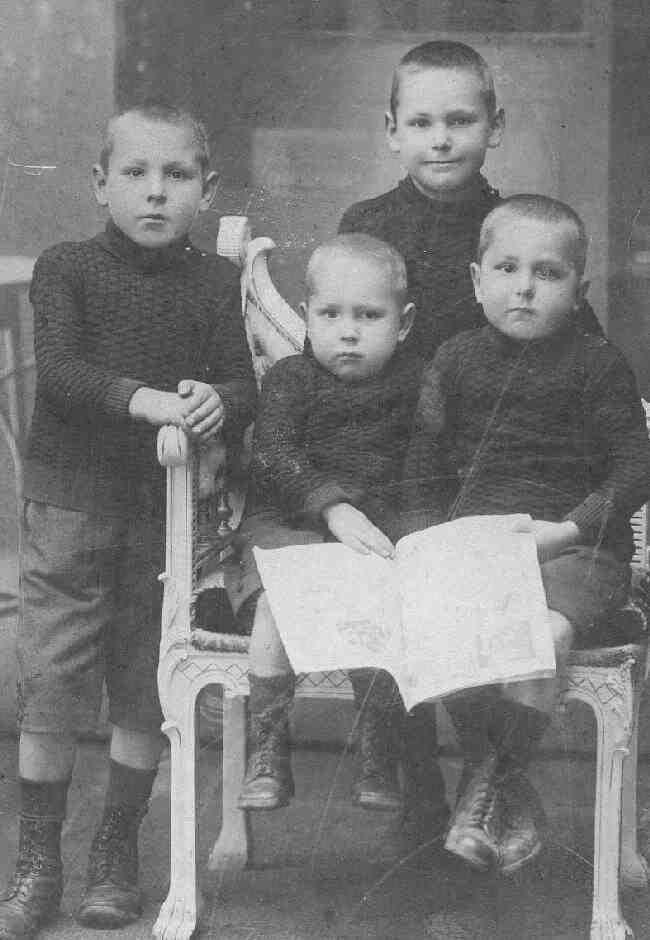
German Boys' Clothes: Coordinated Outfits--Garments

Figure 1.--These German brothers were photographed about 1900 in identical sweaters and kneepants. I'm not sure if the sweaters were store bought or knitted at home. They are from Hamm, Germany. They look to be about 2-8 years of age. Note their hair is also styled identically. Image courtesy of the BP collection.
|
|
The sailor suit was one of the most popular styles used for coordinating the outfits of brothers and sisters. While sailor suits were often used for coordinated outfits, we note very many other outfits being used as well. The German imperial princes wore short pant tunic outfits. We also notice boys wearing similar suits and sweaters and in some instances folk outfits in various styles. There are numerous images on HBCof German children in identical outfits, we will begin to link those images here.
The most frequently used outfit used for dressing children identiclly was the sailor suit. The sailor suit was enormously popular in Germany. This convention was common from the 1890s through the 1930s. We see many family portraits and snapshots of brothers in matching sailor suits as well sisters in matching sailor suits. We also see brothers and sisters wearing sailor suits, in some cases the entire family, rather like the Trapp family in the "Sound of Music". Commonly traditionally styled sailor suits were used. The children might for example wear identical middy blouses, but with pants for the boys and skirts for the girls. Sailor suits were especially popular with middle-class families.
Tunic Outfits
The German imperial princes inthe years before World War I wore short pants tunic outfits.
Suits
We also notice German boys wearing similar suits.
Dresses and other skirted garments were primarily worn by girls. German sisters might be dressed in identical dresses. We see quite a few examples of this. And of course in the 19th century, all girls wore dresses. In most cases they were not identical, but we see quite a few examples of identical dresses. This varied from family to family and was affected by the age of the girls. It was mosdt common with younger girls. We see some teenagers, but not nearly as many. With the exception of sailor outfits, however, this was not as common as for the boys. Younger boys might wear dresses, although this convention was not as strong in Germany as in several other other European countries. We rarely see German boys oldeer than 4 years of age wearing dresses. As a result, we never see family images with all the children wearing identical dresses or even dresses in general. We do see a few brother-sister images of children wearing dresses, including identical dresses. They are not very common and all the ones we have found so far show a girl with a younger brother. We do not have enough examples to assess chronological and stylistic trends. There are probably examples of two younger boys wearing dresses, but they are not very common.
Sweaters
We notice many images of boys wearing identical sweaters. Sweaters especially before World War II were very commonly knitted by mothers and grandmothers. These German brothers were photographed about 1900 in identical sweaters and kneepants (figure 1). I'm not sure if the sweaters were store bought or knitted at home. They were from Hamm, Germany and look to be about 2-8 years of age.
Folk Outfits
We note some instances of childrn wearing folk outfits in various styles. Here there were very destinct styles for boys and girls. The noys wear Tracht including Lederhosden. The girls wear Dirndl, a type of folk dress. Lederhosen becamne very common and were not always worn as folk costumes. We commonly see all or some of the boys wearing Lederhoisen. They were no, hoowever, worn by girls. We do see girls beiining in the 1970s woccsassionsaly wearing Lederhosen.
German children wore a variety of garments when their outfits were coordinated. Sailor suits were the most common, but there were many other outfits as well. Here the gender of the children was a major factor. Younger children in particular wore a range of identical or coordinated outfits. We notice both suits as well as play suits. Almost always the children wore similar or identical tops with skirts for the girl and short pants for the boy. This convention permitted a wider age span and the use of a variety bof garments and styles. There were more limited outfit choices for older children. We do not know muh about the 19th century yet, but we see ecamples from the 20h century, mostly the early 20th century before World War II.
HBC

Navigate the Boys' Historical Clothing German pages:
[Return to the Main German coordinated style page]
[German choirs]
[German youth groups]
[German school uniforms]
[German royalty]
[German sailor suits]
[Lederhosen]
[Ethnic]
[Tights]
[Long stockings]
Navigate the Boys' Historical Clothing Web Site:
[Introduction]
[Activities]
[Biographies]
[Chronology]
[Clothing styles]
[Countries]
[Bibliographies]
[Contributions]
[FAQs]
[Glossary]
[Images]
[Links]
[Registration]
[Tools]
[Boys' Clothing Home]
Created: January 17, 2004
Last updated: 1:40 PM 4/5/2018



